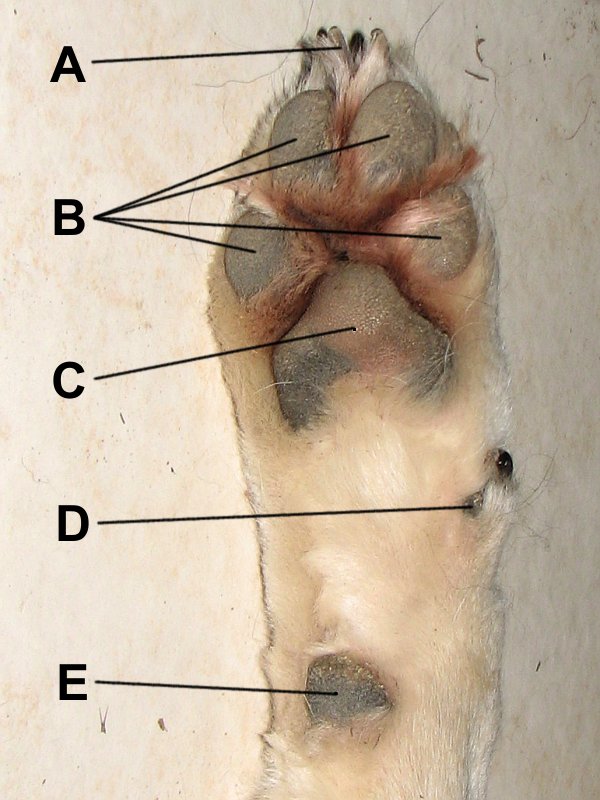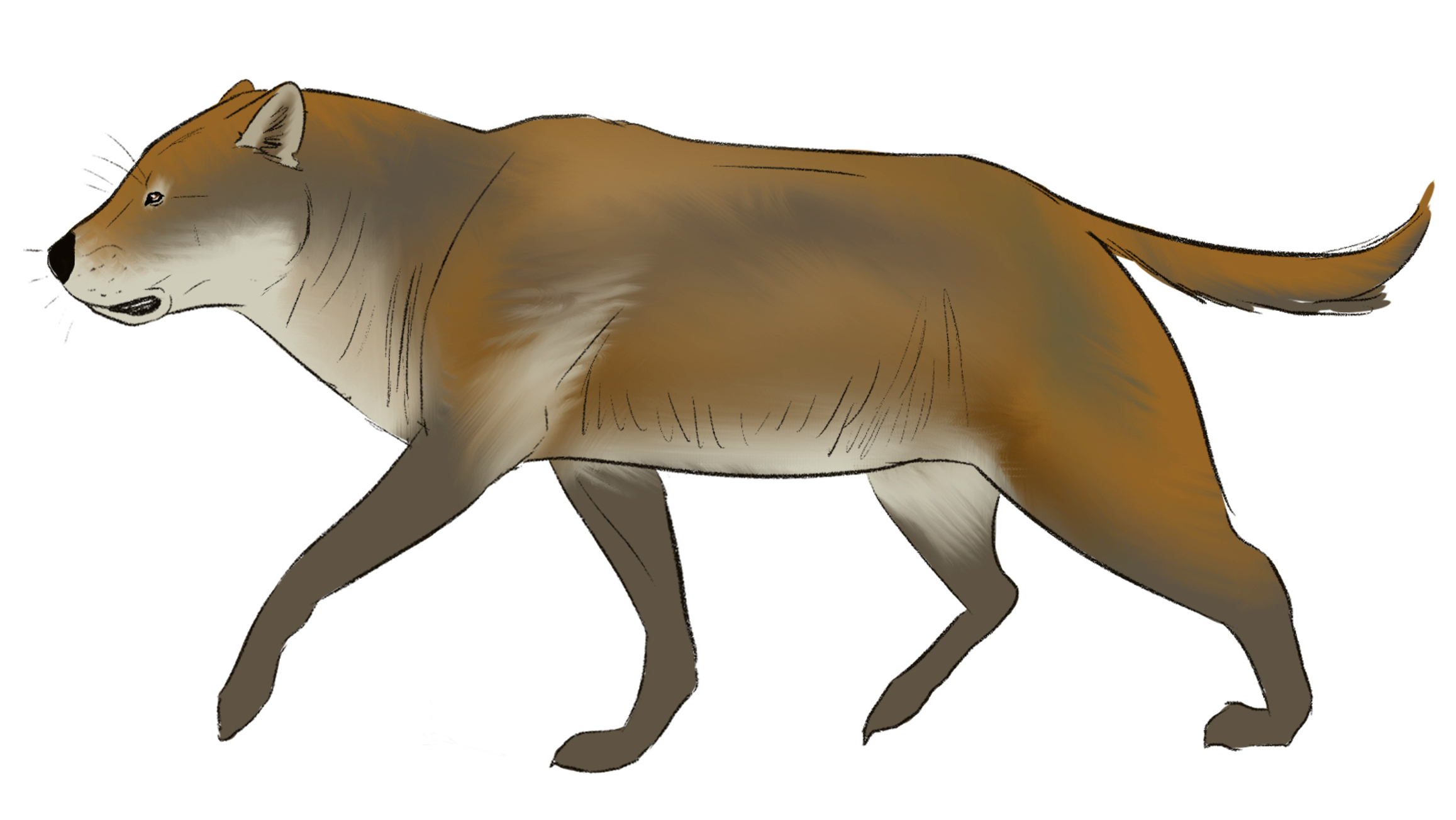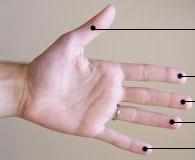|
Dewclaw
A dewclaw is a digit – vestigial in some animals – on the foot of many mammals, birds, and reptiles (including some extinct orders, like certain theropods). It commonly grows higher on the leg than the rest of the foot, such that in digitigrade or unguligrade species, it does not make contact with the ground when the animal is standing. The name refers to the dewclaw's alleged tendency to brush dew away from grass.Danziger, D., & McCrum, M. (2008). ''The Thingummy: A book about those everyday objects you just can't name''. London: Doubleday. On dogs and cats, the dewclaws are on the inside of the front legs, similarly to a human's thumb, which shares evolutionary homology. Although many animals have dewclaws, other similar species do not, such as horses, giraffes and the African wild dog. Dogs Dogs almost always have dewclaws on the inside of the front legs and occasionally also on the hind legs. Unlike front dewclaws, rear dewclaws tend to have little bone or m ... [...More Info...] [...Related Items...] OR: [Wikipedia] [Google] [Baidu] [Amazon] |
African Wild Dog
The African wild dog (''Lycaon pictus''), also called painted dog and Cape hunting dog, is a wild canine native to sub-Saharan Africa. It is the largest wild canine in Africa, and the only extant member of the genus '' Lycaon'', which is distinguished from ''Canis'' by dentition highly specialised for a hypercarnivorous diet and by a lack of dewclaws. It is estimated that there are around 6,600 adults (including 1,400 mature individuals) living in 39 subpopulations, all threatened by habitat fragmentation, human persecution and outbreaks of disease. As the largest subpopulation probably consists of fewer than 250 individuals, the African wild dog has been listed as endangered on the IUCN Red List since 1990. The African wild dog is a specialized hunter of terrestrial ungulates, mostly hunting at dawn and dusk, but also displays diurnal activity. It captures its prey by using stamina and cooperative hunting to exhaust them. Its natural competitors are lions and spotted hyenas ... [...More Info...] [...Related Items...] OR: [Wikipedia] [Google] [Baidu] [Amazon] |
Beauceron
The Beauceron () is a herding dog breed originating from the plains of Central France. The Beauceron is also known as Berger de Beauce (, sheepdog from Beauce) or Bas Rouge (, red-stockings). Description Appearance This breed stands in height and weighs The Beauceron has a hard outer coat and a woolly undercoat that grows thick in cold weather, especially if the dog sleeps outdoors. Its standard colouring is black and tan (the latter colour referred to in French as ''rouge ecureuil'', squirrel-red) or, less frequently, grey, black and tan called harlequin. Other colours, such as the once prevalent tawny, grey or grey/black, are now banned by the breed standard. The harlequin coats should have more black than gray with no white. In the black and tan dogs the tan markings should appear in two dots above the eyes, on the sides of the muzzle, fading off to the cheeks, but do not reach the underside of the ears. Also on the throat, under the tail and on the legs and the chest. Tan ... [...More Info...] [...Related Items...] OR: [Wikipedia] [Google] [Baidu] [Amazon] |
Paw And Pads
A paw is the soft foot-like part of a mammal, generally a quadruped, that has claws. Common characteristics The paw is characterised by thin, pigmented, keratinised, hairless epidermis covering subcutaneous collagenous and adipose tissue, which make up the pads. These pads act as a cushion for the load-bearing limbs of the animal. The paw consists of the large, heart-shaped metacarpal or palmar pad (forelimb) or metatarsal or plantar pad (rear limb), and generally four load-bearing digital pads, although there can be five or six toes in the case of domestic cats and bears (including giant panda). A carpal pad is also found on the forelimb which is used for additional traction when stopping or descending a slope in digitigrade species. Additional dewclaws can also be present. The paw also includes a horn-like, beak shaped claw on each digit. Though usually hairless, certain animals do have fur on the soles of their paws. An example is the red panda, whose furry soles help i ... [...More Info...] [...Related Items...] OR: [Wikipedia] [Google] [Baidu] [Amazon] |
Unguligrade
Ungulates ( ) are members of the diverse clade Euungulata ("true ungulates"), which primarily consists of large mammals with Hoof, hooves. Once part of the clade "Ungulata" along with the clade Paenungulata, "Ungulata" has since been determined to be a polyphyletic and thereby invalid clade based on molecular data. As a result, true ungulates had since been reclassified to the newer clade Euungulata in 2001 within the clade Laurasiatheria while Paenungulata has been reclassified to a distant clade Afrotheria. Living ungulates are divided into two orders: Perissodactyla including Equidae, equines, rhinoceroses, and tapirs; and Artiodactyla including Bos, cattle, antelope, Sus (genus), pigs, giraffes, camels, Ovis, sheep, deer, and Hippopotamidae, hippopotamuses, among others. Cetaceans such as Whale, whales, Dolphin, dolphins, and Porpoise, porpoises are also classified as artiodactyls, although they do not have hooves. Most terrestrial ungulates use the hoofed tips of their toes ... [...More Info...] [...Related Items...] OR: [Wikipedia] [Google] [Baidu] [Amazon] |
Felidae
Felidae ( ) is the Family (biology), family of mammals in the Order (biology), order Carnivora colloquially referred to as cats. A member of this family is also called a felid ( ). The 41 extant taxon, extant Felidae species exhibit the greatest diversity in fur patterns of all terrestrial carnivores. Cats have retractile claws, slender muscular bodies and strong flexible forelimbs. Their teeth and facial muscles allow for a powerful bite. They are all obligate carnivores, and most are solitary predators ambushing or stalking their prey. Wild cats occur in Africa, Europe, Asia and the Americas. Some wild cat species are adapted to forest and savanna habitats, some to arid environments, and a few also to wetlands and mountainous terrain. Their activity patterns range from nocturnal and crepuscular to Diurnality, diurnal, depending on their preferred prey species. Reginald Innes Pocock divided the extant Felidae into three subfamilies: the Pantherinae, the Felinae and the Acin ... [...More Info...] [...Related Items...] OR: [Wikipedia] [Google] [Baidu] [Amazon] |
Polydactyly
Polydactyly is a birth defect that results in extra fingers or toes. The hands are more commonly involved than the feet. Extra fingers may be painful, affect self-esteem, or result in clumsiness. It is associated with at least 39 genetic mutations. It may either present alone or with other defects. Cases may run in families. The underlying mechanism involves an error in limb bud formation during early development. Diagnosis may occur before birth via prenatal ultrasound as early as nine weeks. X-rays may be useful after a child is a year old. The opposite is oligodactyly (fewer fingers or toes). Treatment varies from removal by cautery to more involved surgery. While putting a tight band around the base has been carried out, this is not typically recommended. If surgery is required, this is often done around two years of age. Occasionally multiple surgeries are required. Polydactyly is present in about 4 to 12 per 10,000 newborns. It is the most common defect of the ha ... [...More Info...] [...Related Items...] OR: [Wikipedia] [Google] [Baidu] [Amazon] |
Canid
Canidae (; from Latin, ''canis'', "dog") is a family (biology), biological family of caniform carnivorans, constituting a clade. A member of this family is also called a canid (). The family includes three subfamily, subfamilies: the Caninae, and the extinct Borophaginae and Hesperocyoninae. The Caninae are known as canines, and include Dog, domestic dogs, Wolf, wolves, coyotes, raccoon dogs, Fox, foxes, jackals and other species. Canids are found on all continents except Antarctica, having arrived independently or accompanied by Human, human beings over extended periods of time. Canids vary in size from the gray wolf to the fennec fox. The body forms of canids are similar, typically having long muzzles, upright ears, teeth adapted for cracking bones and slicing flesh, long legs, and bushy tails. They are mostly social animals, living together in family units or small groups and behaving co-operatively. Typically, only the dominant pair in a group breeds and a litter of young ... [...More Info...] [...Related Items...] OR: [Wikipedia] [Google] [Baidu] [Amazon] |
Giraffe
The giraffe is a large Fauna of Africa, African even-toed ungulate, hoofed mammal belonging to the genus ''Giraffa.'' It is the Largest mammals#Even-toed Ungulates (Artiodactyla), tallest living terrestrial animal and the largest ruminant on Earth. It is classified under the Family (biology), family Giraffidae, along with its closest extant relative, the okapi. Traditionally, giraffes have been thought of as one species, ''Giraffa camelopardalis'', with nine subspecies. Most recently, researchers proposed dividing them into four Neontology#Extant taxa versus extinct taxa, extant species which can be distinguished by their fur Animal coat, coat patterns. Six valid Lists of extinct species, extinct species of ''Giraffa'' are known from the fossil record. The giraffe's distinguishing characteristics are its extremely long neck and legs, horn-like ossicones, and spotted coat patterns. Its scattered range extends from Chad in the north to South Africa in the south and from Niger in ... [...More Info...] [...Related Items...] OR: [Wikipedia] [Google] [Baidu] [Amazon] |
Bird
Birds are a group of warm-blooded vertebrates constituting the class (biology), class Aves (), characterised by feathers, toothless beaked jaws, the Oviparity, laying of Eggshell, hard-shelled eggs, a high Metabolism, metabolic rate, a four-chambered heart, and a strong yet lightweight Bird skeleton, skeleton. Birds live worldwide and range in size from the bee hummingbird to the common ostrich. There are over 11,000 living species and they are split into 44 Order (biology), orders. More than half are passerine or "perching" birds. Birds have Bird wing, wings whose development varies according to species; the only known groups without wings are the extinct moa and elephant birds. Wings, which are modified forelimbs, gave birds the ability to fly, although further evolution has led to the Flightless bird, loss of flight in some birds, including ratites, penguins, and diverse endemism, endemic island species. The digestive and respiratory systems of birds are also uniquely a ... [...More Info...] [...Related Items...] OR: [Wikipedia] [Google] [Baidu] [Amazon] |
Digit (anatomy)
A digit is one of several most distal parts of a limb, such as fingers or toes, present in many vertebrates. Names Some languages have different names for hand and foot digits (English: respectively "finger" and " toe", German: "Finger" and "Zeh", French: "doigt" and "orteil"). In other languages, e.g. Arabic, Russian, Polish, Spanish, Portuguese, Italian, Czech, Tagalog, Turkish, Bulgarian, and Persian, there are no specific one-word names for fingers and toes; these are called "digit of the hand" or "digit of the foot" instead. In Japanese, yubi (指) can mean either, depending on context. Human digits Humans normally have five digits on each extremity. Each digit is formed by several bones called phalanges, surrounded by soft tissue. Human fingers normally have a nail at the distal phalanx. The phenomenon of polydactyly occurs when extra digits are present; fewer digits than normal are also possible, for instance in ectrodactyly. Whether such a mutation can ... [...More Info...] [...Related Items...] OR: [Wikipedia] [Google] [Baidu] [Amazon] |
Lion
The lion (''Panthera leo'') is a large Felidae, cat of the genus ''Panthera'', native to Sub-Saharan Africa and India. It has a muscular, broad-chested body (biology), body; a short, rounded head; round ears; and a dark, hairy tuft at the tip of its tail. It is sexually dimorphic; adult male lions are larger than females and have a prominent mane. It is a social species, forming groups called prides. A lion's pride consists of a few adult males, related females, and cubs. Groups of female lions usually hunt together, preying mostly on medium-sized and large ungulates. The lion is an apex predator, apex and keystone predator. The lion inhabits grasslands, savannahs, and shrublands. It is usually more diurnality, diurnal than other wild cats, but when persecuted, it adapts to being active nocturnality, at night and crepuscular, at twilight. During the Neolithic period, the lion ranged throughout Africa and Eurasia, from Southeast Europe to India, but it has been reduced to fr ... [...More Info...] [...Related Items...] OR: [Wikipedia] [Google] [Baidu] [Amazon] |








